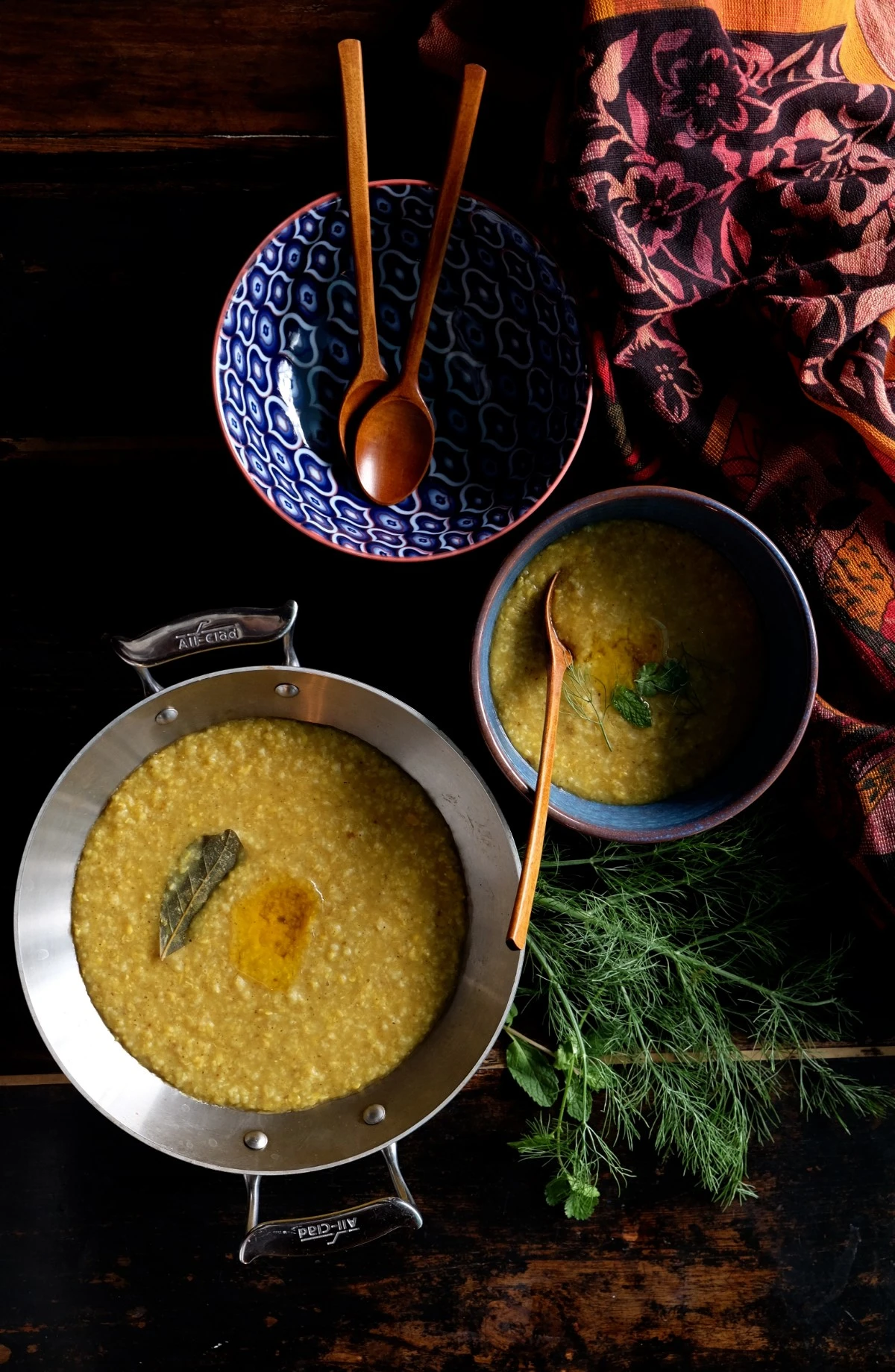kitchari cleanse, the warming winter cleanse
Kichari Cleanse detoxifies the body, drains the lymphatic system, regulates the immune system, and more! Learn about the recipe, directions, and tips for an effective Kichari Cleanse.

Winter is the season of rejuvenation. Like a tree that sheds its branches in Fall and lays dormant waiting for Spring, this is a time when we, too, instinctually want to be less active, rest, and preserve our energy. It’s a more introspective time of year when we have the opportunity to recover from the accumulated effects of the previous year. While cleansing during this cold season can be a bit of a challenge, it is still possible and can be quite beneficial. The key is working with the season rather than against it and fueling our bodies with warming, detoxifying foods rather than cold and raw ones.
There is an Ayurvedic practice which promotes a heartier cooked cleanse, incorporating kitchari (also known as khichadi, kichari or khicharee); basically a vegetarian stew paired with cleansing herbs that supports the body in colder months while still effectively detoxifying the whole system. Typically kitchari is part of a deeper five-step cleanse, panchakarma. However, kitchari can be made and used on its own as a delicious warming and easily digested meal or as part of a whole cleansing practice.
This low fat, high protein, simple mono-meal is quickly digested and nutrients are easily absorbed. Because less energy is spent breaking down foods, the body can spend its energy detoxifying and healing itself.
This cleansing method not only works to detoxify the body, but drains the lymphatic system, regulates the immune system, removes chemicals and fat soluble toxins, cleanses the intestinal mucosa and rejuvenates the nervous system.

Tips for an effective kitchari cleanse:
Only eat when hungry, really listen to your body and what it needs. Often hunger is connected with deeper emotional cravings.
You don’t need to eat 3 square meals a day, find what works for you. Often 4-5 days is the typical length of this cleanse.
Eliminate dairy (with the exception of ghee) and animal products, sugar, alcohol, caffeine, and processed foods
Don’t drink with your meals, but if you must drink room temperature or warm beverages.
Stay away from cold and iced beverages in general as they decrease digestive strength.
Eat your largest meal during mid-day when your digestive fire is at its strongest.
Adjust herbs and spices to suit your tastes and add flavor.
Avoid strenuous workouts and focus on meditation, yoga, rebounding, massage, and breathing exercises.
If you feel the need to eat something besides kitchari while on the cleanse, focus on gently cooked vegetables. You can also supplement with cooked fruits, consumed alone and a couple hours before any other food or meal.

You can adjust the mix of spices to suit your taste. Traditionally, for ease of digestion, kitchari is eaten more like a soup than a pilaf. This is why our recipe includes more liquid than you would normally add for cooking rice.
Feel free to add any gently cooked, seasonal vegetables as a nice addition to the kitchari for a more filling meal.
Kitchari Recipe:
Yields 3-4 servings
1 cup split yellow mung beans
½ cup white basmati rice
1 tablespoon fresh ginger root, peeled and grated
1 tablespoon fresh turmeric root, peeled and grated
2 bay leaves
1 teaspoon each black mustard seeds and cumin seeds
½ teaspoon each coriander seeds, fennel seeds, and fenugreek seeds
8 cups vegetable broth (recipe below) or water
½ teaspoon Himalayan salt
grass fed ghee
1 small handful fresh cilantro, mint, and fennel fronds
Strain the vegetables from the broth; you can either discard the cooked vegetables or reserve them to make a puree to thicken other soups or sauces. Use immediately, or cool to room temperature and store in an airtight container in the freezer.
Kitchari Directions:
1. Wash the split yellow mung beans and rice together until the water runs clear. For ease of and more efficient digestion, soak beans and rice overnight.
2. Add the mustard, cumin, coriander, fennel and fenugreek seeds in a small pan and dry toast them for just a couple minutes until they become fragrant but not burnt. Use a mortar and pestle or a coffee grinder dedicated to spices to finely grind the mixture into a powder.
3. Combine the rice, mung beans, all of the spices and vegetable broth in a large stock pot. Bring the mixture to a boil and allow it to boil for 10 minutes before turning the heat to low. Cover the pot and continue to cook until the rice is soft, about 30-40 minutes.
4. Once the kitchari has finished cooking, stir in the salt.
5. Ladle servings into bowls, finish each bowl with a generous dollop of ghee and garnish with the fresh herbs.
Vegetable Broth Recipe:
Yields 8-10 cups
20 cups filtered water
2 medium-sized white onions, unpeeled, cut in half
4 large carrots, unpeeled and cut into large chunks
2 leeks, trimmed and cut into large chunks
3 bulbs fennel, cut into large chunks, reserve stalks and fronds
1 teaspoon Himalayan salt
Add water to a large, heavy pot. Rinse all vegetables and then add to the pot. Bring to a boil, reduce the heat and simmer, uncovered, for 1 hour. Taste and adjust the seasoning if needed and continue to simmer for 30 minutes longer.

[…] Kitchari […]